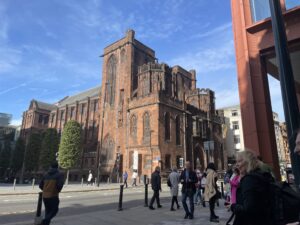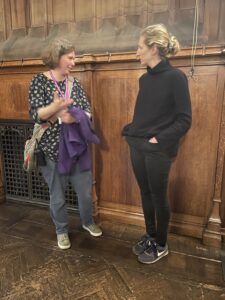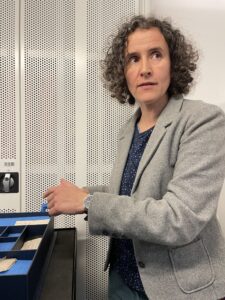The Megillah at the Rylands
The Megillah at the John Rylands • The John Rylands

The John Rylands
The first Collection Encounter for the Hidden Treasures team was at the John Rylands Research Institute and Library in Manchester, which became part of the University of Manchester in 1972. Housed in a magnificent sandstone building in the bustling city center of Deansgate, this impressive institution looks more like a cathedral than a library from the outside. We entered via a modern glass and steel extension and were met in the foyer by the Curator of Global Manuscripts at the institute Dr Zsófia Buda, who specializes in Hebrew manuscripts and her colleague Dr Elizabeth Gow, a professional archivist and manuscript curator. For the rest of the day these brilliant women took us on a remarkable tour of the building, telling us about the history of this place and showing us some of the unique hidden treasures in their collections that relate to Jewish life and culture.

Dr Elizabeth Gow and Rebecca Singer
Soon after we entered the John Rylands Library itself, which is one of the finest examples of neo-Gothic architecture in Europe. Flooded with light with its high vaulted ceilings, clerestory-stained glass windows along both sides, and stone statues lining the walls this magical space is more reminiscent of a medieval castle than any library I had visited before. Coming off the central aisle are alcoves lined with cabinets filled with beautiful leather-bound books and desks for readers to work. According to online sources, the producers of Harry Potter made a visit to the John Rylands Library and took photos, which inspired the film sets for Hogwarts in the resulting movies and the influence is clear, the place is magical.
Elizabeth is a global expert on the library’s founder, the Victorian collector and philanthropist Enriqueta Rylands. She explained that this Cuban born woman, married the Manchester cotton merchant John Rylands and after he died, she founded the library in his memory. Enriqueta collected books, from dealers and bookshops, auction houses and specialists between 1889 and 1908. Many of the collections that exist in the building today were started by this trailblazing woman who gifted this major educational and cultural institution and its special collections to the people of the city. Elizabeth showed us the life size white marble statue of this lady at the far end of the library space. When this statue was unveiled in 1907, the Vice Chancellor of the Victoria University, Professor Hopkinson, said that they owed Enriqueta Rylands a great debt, not only for endowing the library but also for her generosity in ‘filling it with those treasures which could only be got by lavish and princely generosity and by direct personal care and interest in the work.’
We followed our guides out of the historic reading room and through the cloisters, whose low vaulted ceilings, flagstone floors and darkly lit hallways were extremely evocative. We walked up a maze of corridors and stone stairwells until we entered the conservation room, a brightly lit, impeccably clean, modern room filled with equipment for the conservation and protection of the items from the Rylands collection.

The Megillah (the book of Esther scroll) we had come to see was laid out on a large table in the center of the room. Zsófi explained that this extremely rare item had been purchased for the university collections in 1915 from the Manchester based bookseller J.E. Cornish for 10 shillings. ‘After accession the item was kept in a box and almost forgotten for decades. Luckily this extraordinary object was recently located in our storage by my predecessor Dr Stefania Silvestri, and it is now undergoing an intensive restoration programme.’

We gathered around the table in awe, admiring the extraordinarily delicate parchment cut-out design of the scroll, as conservator Laura Snow told us more about the rarity of the item we were looking at. ‘There are only three more of this kind that survive. This is the only one that has pigmented paper,’ she said pointing to the faint green and red coloring on some of the parchment. ‘The other three scrolls are in museums in Amsterdam, London, and Toronto. The relationship between our megillah and the other three scrolls would require an in-depth study,’ Zsófi added. ‘DNA testing will help us find out more.’

She thinks the scroll was most probably made in Italy and is thought to date to the eighteenth century. ‘The design is particularly intricate because of the three-dimensional element. The scroll is made of 3 strips of parchment sewn together, backed by a long strip of purple silk dyed using cochineal, which is made of small, crushed bugs,’ explained Laura. The Hebrew text of the book of Esther was inscribed in ink into gate-shape designs on the parchment, which were surrounded by intricate and at times figurative designs. ‘The text and the filigree are all on the same piece of parchment,’ said Zsófi. ‘The workmanship is exceptional.’
We could see winged figures climbing Jacob’s ladder, and the sacrifice of Isaac. There were also birds of prey, insects, flowers, dragons and even a crocodile surrounding the text as well as hunting scenes and vignettes of local life. I could have stayed there for hours examining these amazing designs.

Dr Zsofia Buda
The scroll itself was unstable in parts and had disintegrated in sections, where only fragments remained. Heather Garner the newest member of the team, a paper conservator, told us she will be working on the Esther Scroll for the next six months with an external textile conservator. ‘It’ll involve a lot of collaboration to work out how all the elements fit together and how they can be joined.’ She expressed her deep excitement, ‘It’s not very often that a rare object such as this comes across our path.’
‘First, we’ll be documenting the precise location of these loose fragments’ said Heather, pointing to some tiny remnants which looked as fragile as a butterfly’s wing. ‘Then we’ll clean the surface using very fine brushes and an eraser. Further along the scroll there are some quite severe undulations in the parchment because it’s a skin and naturally moves in a particular way and it’s been rolled for a very long time.’ Her colleague handed her a snake weight and she very carefully unrolled the scroll further, as we all held our breath.
Eventually when the scroll is restored, they told us they plan to show it in one of their renovated exhibition spaces ‘as a treasure, and not necessarily show it constantly, but have a little sort of shiny moment for this scroll, because it’s been kind of forgotten.’ Before we left Rebecca, a member of the Hidden Treasures team, moved closer to the scroll and found the section that relates to the part of the text where Mordechai asks Esther to visit the Persian King’s palace and she agrees to go to Ahasuerus to ask him to save the Jewish people. ‘It’s just amazing, she noted, ‘because 17th or 18th century English manuscripts would be difficult to read but this Hebrew text is the same as it would be today in a contemporary Megillah.’ And then she sang to us in Hebrew, from the eighteenth century Megillah, in the modern wing of that nineteenth century building, connecting us across time.
–Dr Rachel Lichtenstein
Read more about the Megillah here.